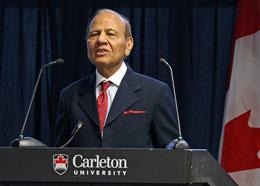Indo-Canadian A-Listers excel in many ways

Photo caption:
Ajit Jain, author of The A-List, speaking at Carleton University./ Photo Credit: Supplied
By Anita Singh
Special to The Post
Ajit Jain is a three-decade chronicler of the Indo-Canadian community. His role as a journalist and editor for India Abroad’s Toronto edition and more recently, a contributor to TheIndianDiaspora.com has brought Jain in contact with Indo-Canadian trailblazers as he writes about issues relating to the community and the development of Canada-India relations. This unprecedented, long-time access has given Jain an excellent position from which he developed his most recent book, The A-List.
Why The A-List?
The A-List is an extension of India Abroad’s The Power List. It profiles 50 individuals from the Indian diaspora in Canada and three non-Indians, who Jain calls “Friends of India.” In addition, he profiles six organizations that are active in the social development of India or those working to improve Canada-India relations in this important time of political transition.
The A-List, rather than being a mere short-form biography of 50 important people within the Indo-Canadian community, has some underlying themes that are key to the story of Indian immigration to Canada.
“These are not just people who have made millions, they are people who contribute to the community through their philanthropy and intelligence,” Jain says.
Defying stereotypes
The book does an excellent job at highlighting the diverse successes of the Indo-Canadian community.
It tacitly shows how Indo-Canadians have defied the stereotypes that have persevered in the West, assuming Indians excel in only a handful of professions as doctors, lawyers, or computer engineers.
Instead, The A-List profiles a range of individuals, including businesspeople (Prem Watsa of Fairfax Investments), politicians (new cabinet members Bardish Chagger, Harjit Sajjan, Amarjeet Sohi and Navdeep Bains), researchers and academics (Baldev Nayar and Dilip Soman), and entertainers (TV personalities Omar Sachadena and Vikram Vij).
In each case, Jain has selected individuals that have gone above and beyond the call of duty to become major players in their industries, prolific and engaged beyond their professions to contribute to the larger Canadian community.
Jain says that these individuals were selected because “we wanted to capture successes by Indo-Canadians nationwide and in all disciplines.”
Histories of immigration
All the Indo-Canadians profiled in The A-List are either first- or second-generation Indians, having first-hand experience in many of the initial culture shocks and challenges inherent in immigration to the West.
Language barriers, poverty, cultural isolation, and limited early job prospects play an important role in defining early generations of immigrant communities. Like the individuals profiled in The A-List, immigrants have to overcome these barriers through hard work, dedication and an interest in providing their families with the benefit of a new life in Canada.
The book highlights how these individuals have used their immigrant experiences to further their personal successes in Canada.
Take Steve Rai, who says “the purest form of community policing is found in Indian villages where everyone knows everyone.”
Rai uses this example to create inroads into communities across the greater Vancouver region. With this experience, Rai has risen in ranks in the Vancouver police department and recently named deputy chief constable – the first South Asian to hold this post.
Maintaining ties to India
Jain does not limit his analysis to individuals that have been personally and professionally successful. He pointedly includes individuals and organizations that have been central to defining better relations between Canada and India.
He profiles individuals like professor Mathiew Boisvert from the Université du Québec à Montréal who has actively worked to raise interest in Canada on the contemporary culture and religion of people in India. His current work on the Hijira community in Maharashtra examines the social, legal and anthropological elements of this Indian subculture.
Similarly, Jain also includes six organizations in this esteemed list, focusing on the work of charitable organizations like AIM for SEVA and Child Haven International, which use their notable profiles in Canada to do work to improve the lives of underprivileged children in India.
In each of the stories highlighted in The A-List, Jain weaves a narrative that intimately connects each profiled individual back to India.
The next step
The A-List is an excellent snapshot that celebrates the best and brightest within the Indo-Canadian community. It does invariably miss a larger narrative on the less bright and shiny side of Indian immigration to Canada – an account of the taxi and truck drivers, cleaners and manual labourers who continue to struggle to create a better life for themselves and their families.
As successful as the community has become on many fronts, there is an equally notable silent majority in the Indo-Canadian community that continues to face poverty, domestic violence and racism while looking for their opportunity to grow and prosper in Canada.
To his credit, this has not gone unnoticed by Jain. His upcoming book, Violence against Women – All Pervading, co-sponsored by the Elspeth Heyworth Centre for Women in Toronto, is a journalistic view of the pervasiveness of violent crimes against women, recognizing this prevalence in the Indo-Canadian community.
Anita Singh is a Research Fellow at the Centre for Foreign Policy Studies at Dalhousie University. Her research examines the role of diaspora groups and their influence on foreign policy, particularly the Indo-Canadian community and Canada-India relations.
This piece was originally appeared in New Canadian Media (newcanadianmedia.ca). See http://newcanadianmedia.ca/item/33547-indo-canadian-a-listers-excel-in-many-ways









